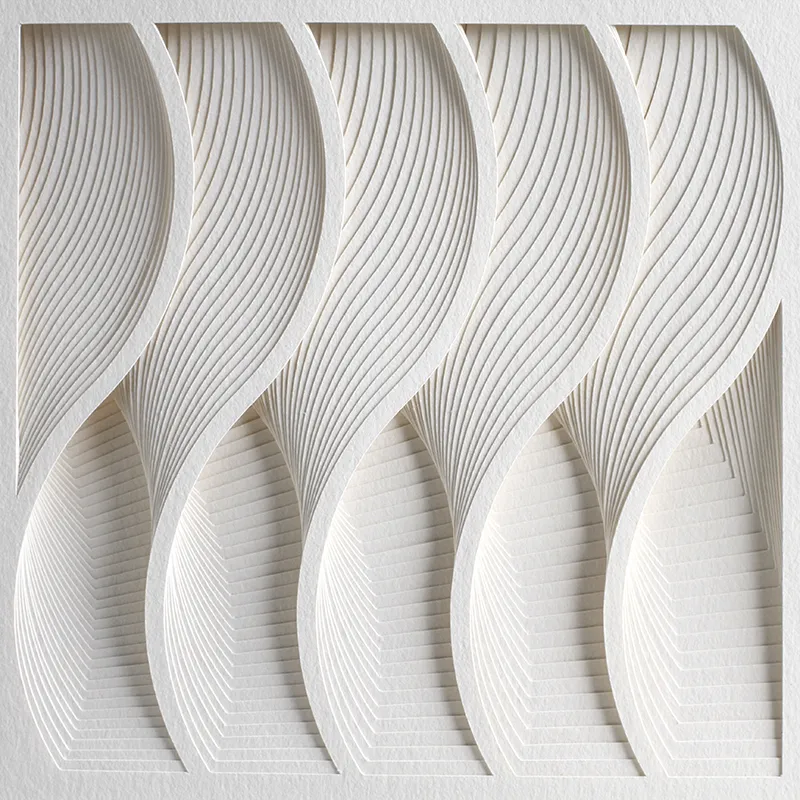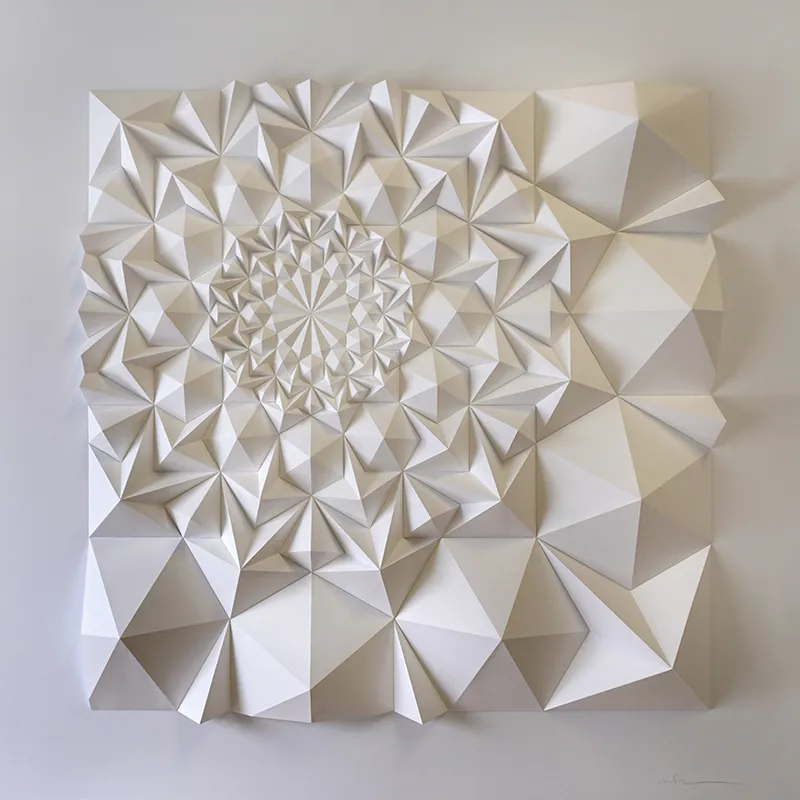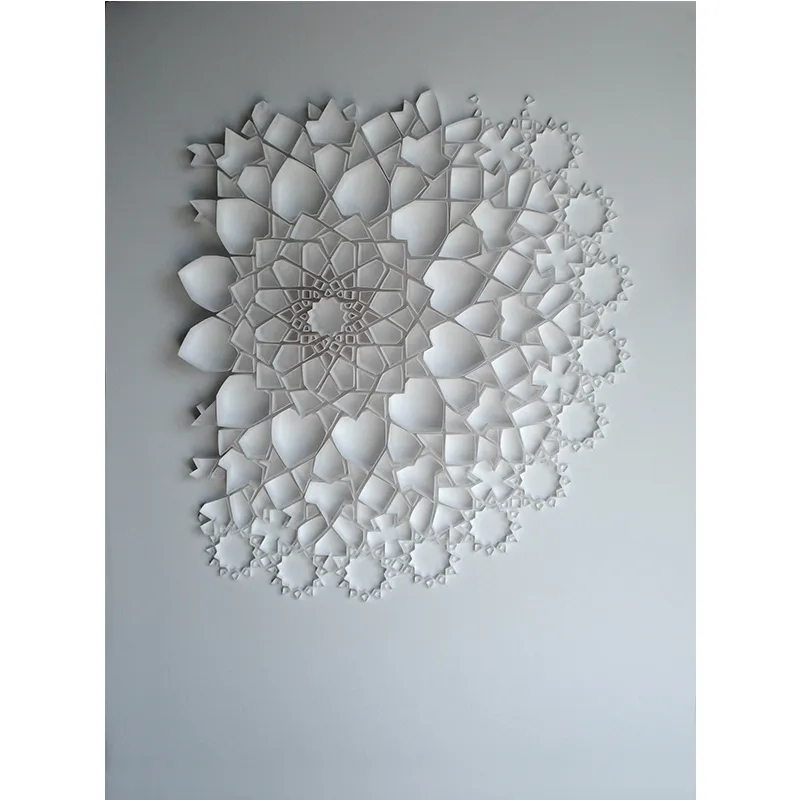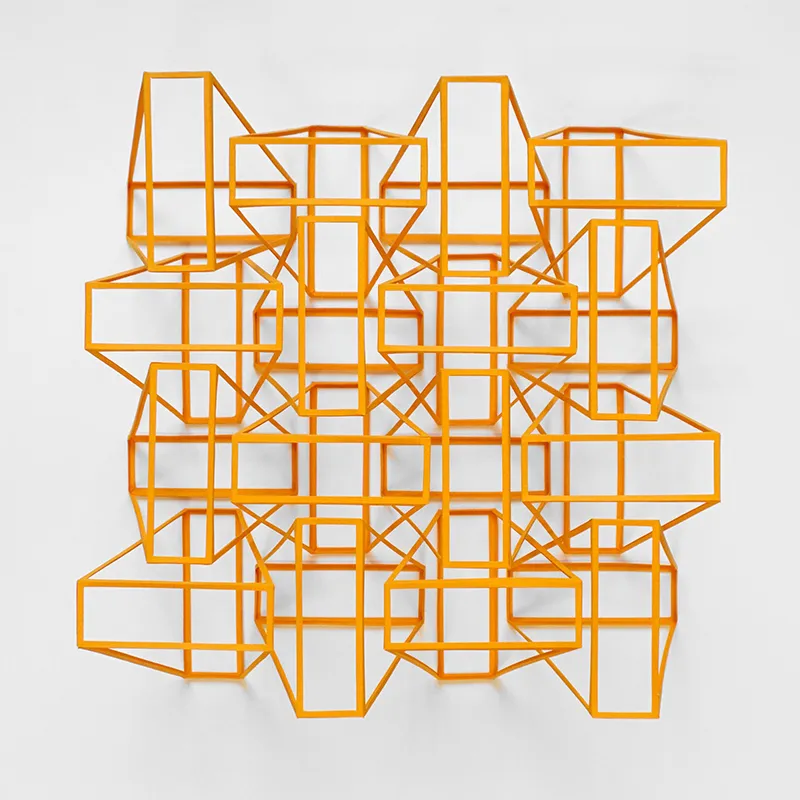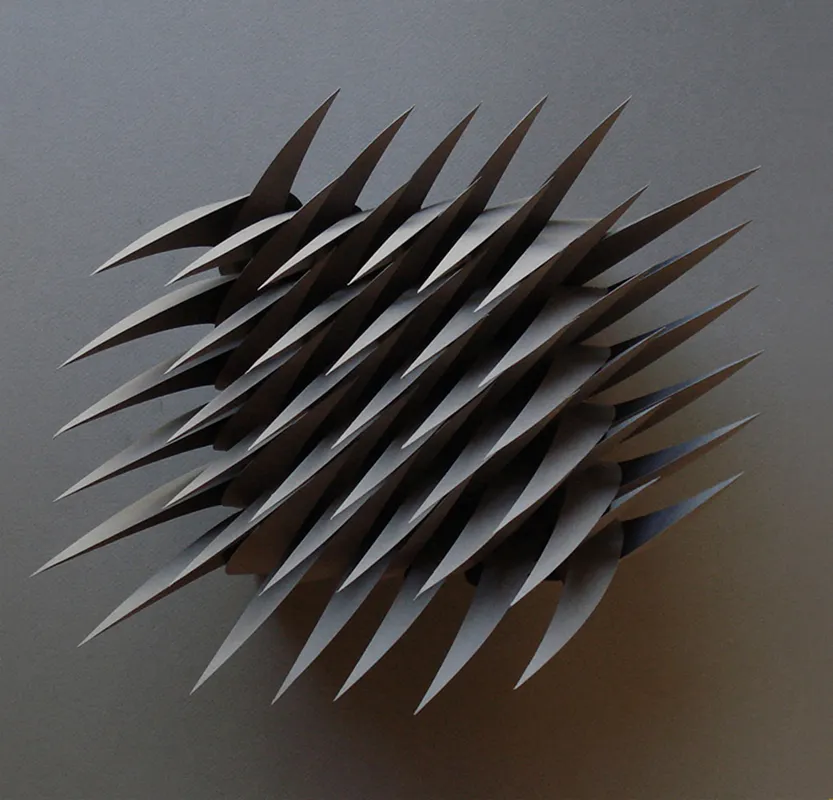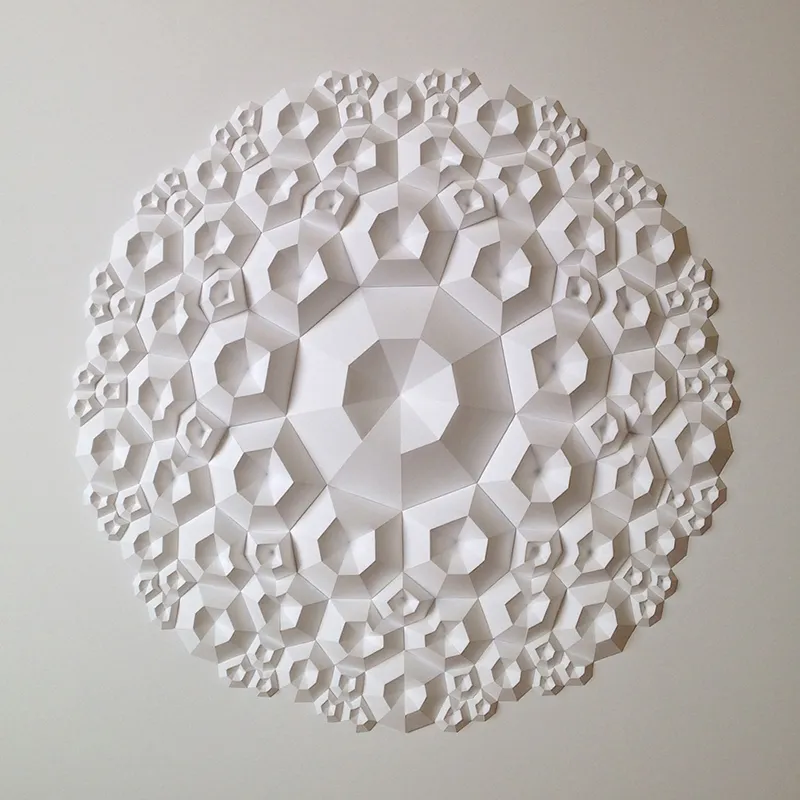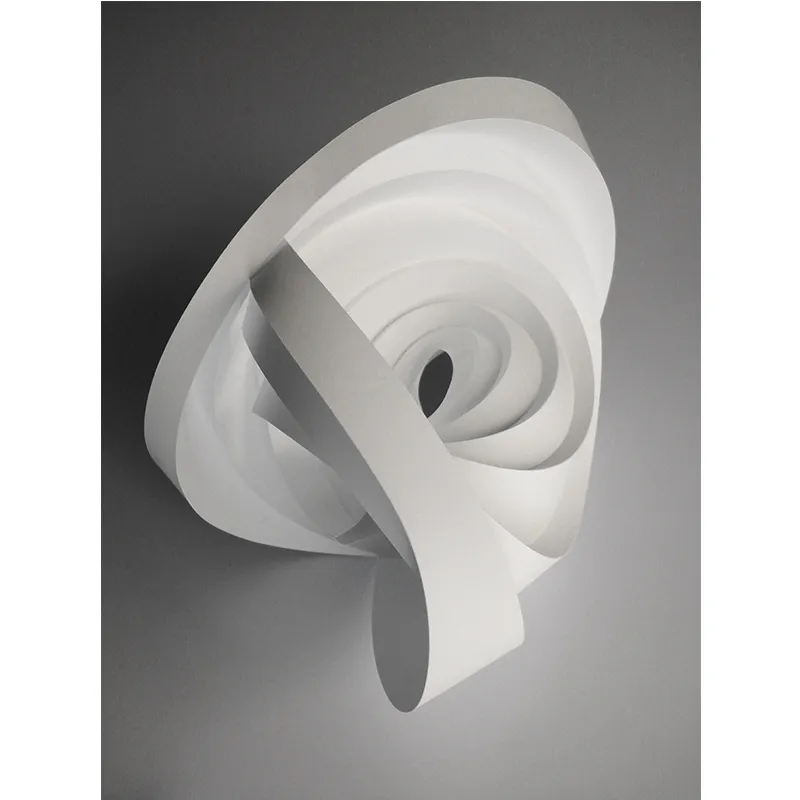These Mesmerizing Paper Sculptures Explore Nature’s Mirrored Structures
Artist Matt Shlian folds, cuts and glues paper to create faceted and curved works of art
Matt Shlian used to design popup books and greeting cards. Now he collaborates with scientists who create more efficient solar panels, solve complex mathematical problems and understand how proteins inside cells can fold incorrectly and cause disease.
The Ann Arbor, Michigan-based artist creates abstract sculptures out of folded, sliced and glued-together paper. He designs them on a computer and sends the files to a flatbed plotter cutter—a tool that scores the paper using a small titanium blade. Then each piece is folded, shaped and glued by hand.
There's a serenity to the works' clean lines, but also movement. It's as if the geometric patterns seen in Islamic art have come to life and replicate across a smooth field. Bubbling, living crystal facets push up and almost beg to be stroked with a gentle fingertip.
His initial desire in creating the pleated works was to explore form and light, but his impulses stray from the purely artistic. He shows his creations to scientists and asks: What could you do with this?
In the clean lines and polygons Shlian sculpts in paper, the scientists see structures they've been pondering and, in the best cases, an avenue to some new insight. At his first talk given to scientists at the University of Michigan, Shlian showed a creased form that could rotate around itself. The artist recalls cell physiologist Daniel Klionsky standing and shouting, "That's it! That is it!" The shape turned out to be the same as a doubled-walled structure inside cells that Klionsky was studying called the autophagosome, which helps recycle spare cellular parts. Collaborating with Shlian helped the researcher better visualize the way the autophagosome moves.
Max Shtein, a chemical engineer at the University of Michigan, and his group saw a mesh structure that Shlian created by slicing paper and applied it to solar panels they were developing. The stretchy structure allows the panel to track the sun's movements.
Ask Shlian about any of these discoveries, however, and he'll downplay his contributions. "Even though the pieces look very systematic and very planned, that comes much later," he says. On his website, he explains that his best pieces typically arise out of a mistake that "becomes more interesting than the original idea."
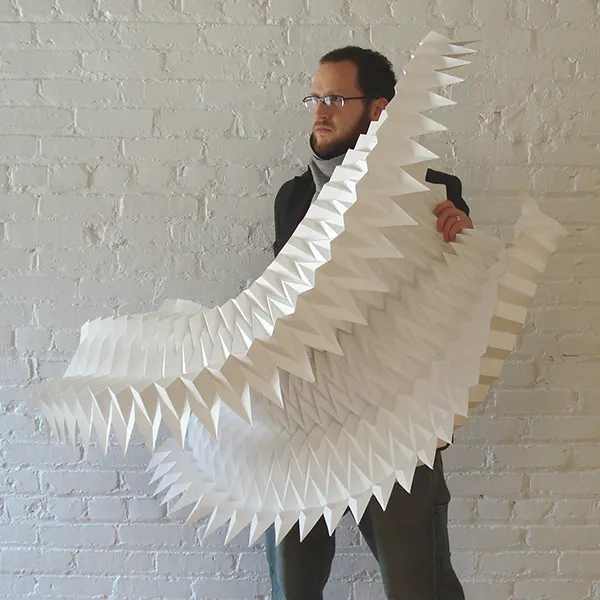
Shlian has an insatiable curiosity. His work incorporates influences from paper craft, kirigami (which he describes as origami plus cutting), Islamic art, architecture, biomimetics and music. In a new exhibition at the National Academy of Sciences in Washington, D.C., he explores the idea of chirality.
The word chiral comes from the Greek word for hand, ''χέρι," and hands are indeed the simplest way to explain the concept. The left and right hand are mirror images of each other: You can easily place them palm to palm and see how each finger lines up with its partner on the opposite hand. But no matter how you twist and turn one hand, it will never match the exact orientation of the other. If the thumbs both point right, you are looking at the back of one hand and the palm of the other.
"The more I talked to scientists, the more I realized that chirality is big part of how we build," Shlian says. In the "Chirality" exhibition, his works remain static, but their forms evoke swirls, twists, turns and repetition that relate to the phenomenon.
This type of asymmetry pops up in nature all the time, but chemists pay particular attention to chirality. Molecules of the same chemical composition often exist in two configurations that are mirror images of each other. These paired, left- and right-handed versions of molecules are called enantiomers, and the different forms change the way that molecules behave. For example, the oils found in caraway seeds and spearmint have distinctive smells, but the molecules responsible differ only in their chirality.
For reasons scientists are still investigating, nature often favors one enantiomer over the other. DNA is almost exclusively right-handed in living organisms, and left-handed, or Z-DNA, can only form under certain conditions. Crack open the cells of anything from pond scum to tortoises to humans and the DNA strands within will spiral-staircase to the right.
Chirality's importance came into stark, terrible focus more than half a century ago. In the 1950s, a German pharmaceutical company developed a sedative pill they said was so safe that pregnant women could take it for morning sickness. They called it thalidomide. When chemists synthesize molecules, the reaction usually spits out a mix of left- and right-handed products. In the case of thalidomide, the left-handed version was helpful and the right-handed version was toxic. If taken during the first trimester of pregnancy, the toxic enantiomer strangled the development of new blood vessels in the fetus. The drug was pulled from the market in 1961, but not before more than 10,000 babies were born with shortened or missing limbs and other birth defects.
Many of those children are now adults and still grappling with health consequences today. Fortunately, the mistake led to massive reforms in the way that pharmaceuticals are regulated.
Chirality is found in many branches of science—from biochemistry to mathematics. Shlian came across the concept when he started working with researchers in Sharon Glotzer’s lab. Glotzer, a chemical engineer at the University of Michigan, and her colleagues look at structures at the nano level, including those that can self-assemble.
"They are putting all of these polyhedral, multifaceted shapes—think of 20-sided dice—in a box and shaking it,” Shlian says. "The shapes all kind of nestle and create a form." Another analogy might be if you put Legos in a dryer and ran it for a while before stopping to see if any managed to snap together and build shapes.
Engineers like Glotzer can use the information they glean from these experiments to understand how to invent new materials that could be used to build batteries or even render objects they coat invisible. "A lot of this research is in the distant future," Glotzer says on her university profile page, "but the fundamental principles of self-assembly that my students and I are discovering are laying the foundation for that future."
This research inspired Shlian's piece titled "Apophenia." He explains that if you sliced through the self-assembled shape created by shaking a box of polyhedrons, you might see some of the patterns that are in the artwork. "Apophenia," one of 10 that appear in the exhibit, is rendered in pure white paper, but it looks like a jumble of cut gemstones or the reflected facets seen inside a kaleidoscope if all the color fled.
A viewer may see tiling and patterning, but it is an illusion. The shapes have the asymmetry of chirality, and they are mirror images that don’t quite match up. "'Apophenia' is actually dealing with seeing patterns where patterns don't actually exist,” Shlian says.
The piece also gets to the heart of Shlian's vision of chirality, a perspective that folds in the tragic lesson of thalidomide.
"It is a presumptuous thought that we understand nature and have dominion over it," he says. "Chirality makes us think: Do we really understand what is happening at a small scale?"
The typical viewer might not see that question as they gaze at the planes and curves of Shlian's sculptures, but the artist isn't setting out to teach. Like his work does for his scientist collaborators, he hopes to spark curiosity.
“Chirality” opened on August 15 and will remain on view until January 16, 2017 at the National Academy of Sciences at 2101 Constitution Ave., N.W., Washington, D.C. Learn more about Shlian’s work in this recorded artist’s talk and at his website.
